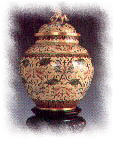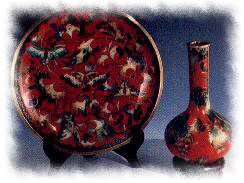Design Arts -- Cloisonné
Cloisonné also known as Cloisonnéenamel, is the decorative art of applying enamel of all colors to the surface of a copper or bronze object which is then fired to become a bright and colorful work of art. This artistic technique did not originate in China; it was in fact transmitted from the West and reached its peak of perfection as a result of Chinese artisans. Chinese Cloisonnébecame the standard by which to measure the quality and appraise the beauty of Cloisonnéall over the world, and it ranks as one of China's major contributions to the world's fine arts.
Tradition
The technique for Cloisonnéenameling was passed onto China by missionaries from central Asia sometime in the early to mid-14th century. After mastering the skill of manufacturing enamel products, the Chinese constantly improved and enhanced this special technique, thus making it a distinctly Chinese art. During the mid-15th century of the Ming dynasty, Cloisonnéproduction was extremely prosperous, and many Cloisonnéworks of the most delicate quality were produced.

|
The general method for making Cloisonnéinvolved first soldering brass wires or copper strips to the surface of a copper object to form a pattern or illustration, then, according to the requirements of each pattern, colored enamels were filled in.
Enamel was made by melting different materials such as red lead, boric acid borate, and glass powder together to become an opaque or translucent glistening substance. A variety of oxidized metals were added, and the substance then changed into enamels of different colors. After the melted enamel cooled and became solid, it was then ground into powder and mixed with water prior to the filling in process.
After the spaces delineated by brass wires on the copper object were filled in with enamel paste, the object was then fired. After every firing, the enamel would contract, producing an uneven surface. It was then necessary to fill in the uneven places with enamel paste of the same color many times over. This procedure had to be repeated many times until every filled-in space became thoroughly smooth without any depressions. Only then was the firing process complete.

|
Modern Day
In recent years, this kind of traditional art work has once again drawn public notice. Many people are fusing modern machines and industrial technologies with artistic creativity to produce a variety of Cloisonnéornaments, art works, and household utensils. This has allowed the integration of classic Cloisonnéinto modern life.
An exquisite piece of Cloisonnémust have colors that are glossy, fresh, and bright, a body that is substantive and sturdy, a wire inlay that is neat and well-proportioned, and gold plating that glitters. The making of Cloisonnécombines bronze and porcelain-working skills with traditional painting and etching.



 Chinese Culture
Chinese Culture